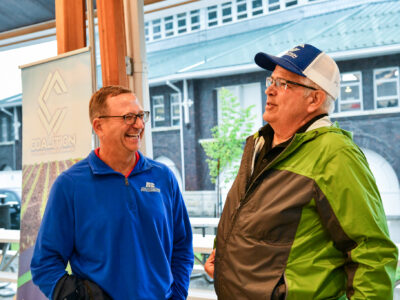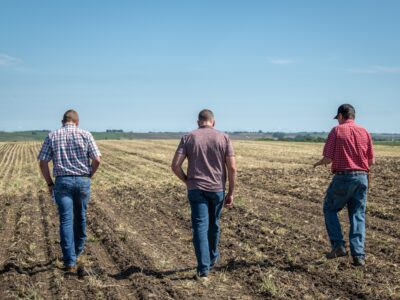Growing the Ag Environment
04-25-2024 in Anniversary
Ryan and Lana Reed of Wapello County spent an almost-spring-like March day tending to the windbreak near two of their hog barns.
Planted in 2010, the fast-growing austree hybrid willow trees, common in new windbreaks for providing cover until other trees grow to maturity, were nearing the end of their life.
“We don’t need them anymore. The pine trees are big enough now,” says Reed. The austrees were planted along with two rows of evergreens and a row of shrubbery.
A windbreak is a long-term investment, and while the austrees have outlived their usefulness, the windbreak has not.
“Planting windbreaks on livestock and poultry farms has many benefits, including improving relationships with neighbors, improving aesthetics, and providing visual screening. Trees also reduce odor, reduce storm run-off and erosion, and can help conserve energy,” says Brian Waddingham, executive director of the Coalition to Support Iowa’s Farmers.
Reed planted his windbreak with the help of CSIF’s Green Farmstead Partner program, one of the first to do so when the program began 15years ago. Assisted by Trees Forever and the Iowa Nursery and Landscape Association, the program focuses on plantings at livestock facilities to add aesthetics and energy savings as well as odor control. Iowa State University research shows windbreaks can reduce odor around livestock barns and feedlots by as much as 30%.
 Along with odor control, he sees a marked impact on utility bills and flourishing wildlife, including a pair of owls that live in the windbreak. “That’s pretty unique, to have something like that end up at your place.”
Along with odor control, he sees a marked impact on utility bills and flourishing wildlife, including a pair of owls that live in the windbreak. “That’s pretty unique, to have something like that end up at your place.”
The Green Farmstead Partnership program links livestock farmers with a select group of trained landscape professionals. The cost of the referral is free and available to all farmers, along with information on cost-share programs for trees and installation expense.
CSIF connected Reed with Kelly Tree Farm LLC of Mechanicsville. Kelly Tree Farm has been a leader in designing and planting windbreaks around livestock farms for more than 50 years.
Owner and manager Jacob Dohmen says many of his customers quickly realize the value of their investment.
“No one I’ve worked with has ever been disappointed by planting a windbreak, they usually wish they would have done it years ago,” said Dohmen. “For one, it helps from a neighbor relations aspect, especially for farms located on main highways, and secondly, trees can lessen energy costs by protecting barns from weather elements and providing proper ventilation.”
When his trees were planted, Reed was facing concern from neighbors in siting his two hog barns. In addition to working with neighbors on the roads he would use and adding the proper pit additives, he also included a windbreak to help make neighbors more comfortable.
“Taking on the time and expense of adding a windbreak was a game changer,” said Reed. “Once neighbors know you’re invested in the neighborhood, trust is built. And the windbreak was key to building that trust.”
“A major benefit to farmers is that by participating in the GFP Program, it visually demonstrates to their neighbors and community members their commitment to enhancing the environment,” says Waddingham. “Planting trees is a commitment – both financially and the time spent planting, mulching, watering and maintaining them.”
Reed not only earned the respect of his neighbors, but his approach also helped bring recognition as a winner of the 2012 National Pork Producers Council Environmental Stewardship Award and the Good Farm Neighbor Award.
Reed has added a third facility since, with the three barns housing a total of 14,500 hogs.
For Reed, the effects of the windbreak bring an added advantage. He has a son and daughter in college and a son in high school with thoughts of returning to the farm. “That’s the purpose of the whole project,” says Reed.
Reed didn’t start out with the benefit of an immediate family farming operation to enter, although his family did own some ground. He’s seen how hard it is for young people without that sort of support to enter farming and be able to do it at economies of scale.
He’s also seen first-hand the obstacles of public opinion, the value of good neighbor relations and how those elements affect the future of farming in his area.
“The stage is set. The windbreak has been a huge help with our neighbors and part of the success of livestock operations in this area,” says Reed. “Some of those people who first opposed us now own hog barns, made possible, in part, because mine is received in a good light.”
“There are two environments we as farmers out here in rural areas need to take care of,” continues Reed, “the social environment and the physical environment. Our windbreak has helped us do both.”
CSIF is a non-profit, non-lobbying organization formed in 2004 to help livestock farmers “do it right.” Funded by the Iowa Beef Industry Council, Iowa Cattlemen’s Association, Iowa Corn Growers Association, Iowa Farm Bureau, Iowa Pork Producers Association, Iowa Soybean Association, Iowa Turkey Federation, Midwest Dairy and the North Central Poultry Association, it helps farmers interpret rules and regulations for siting and offers counseling for good neighbor relations and positive environmental impact. All at no cost to farmers.
(By Terri Queck-Matzie for CSIF. Queck-Matzie is a freelance writer from Greenfield).
Recommended News

State Fair Celebration Honors 20 Years of CSIF
In the 20 years since the Coalition to Support Iowa’s Farmers (CSIF) was formed to help farmers grow responsibly and successfully, CSIF has become the go-to resource for questions about...
Read More
Twenty Years of Meeting Farmers’ Needs
In 2004, the Coalition to Support Iowa’s Farmers was formed to help Iowa’s livestock farmers implement best management practices, properly site locations for new livestock barns and feedlots, interpret growing...
Read More
Committed to Doing Things Right
Mike Lambert heard about the Coalition to Support Iowa’s Farmers (CSIF) while listening to the radio one day. He was a young farmer looking at possible avenues for growth. He...
Read More